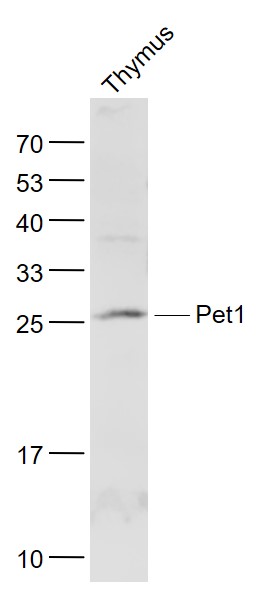
Rabbit Anti-Pet1 antibody
ETS-domain transcription factor; FEV; FEV_HUMAN; Fifth Ewing variant protein; mPet1; PC12 ETS domain-containing transcription factor 1; PC12 ETS factor 1; Pet-1; Protein FEV.
View History [Clear]
Details
Product Name Pet1 Chinese Name ETS结构域转录因子FEV抗体 Alias ETS-domain transcription factor; FEV; FEV_HUMAN; Fifth Ewing variant protein; mPet1; PC12 ETS domain-containing transcription factor 1; PC12 ETS factor 1; Pet-1; Protein FEV. Research Area Tumour Neurobiology transcriptional regulatory factor Alzheimer's Immunogen Species Rabbit Clonality Polyclonal React Species Mouse, (predicted: Human, Rat, Chicken, Cow, Horse, Sheep, ) Applications WB=1:500-2000 ELISA=1:5000-10000
not yet tested in other applications.
optimal dilutions/concentrations should be determined by the end user.Theoretical molecular weight 25kDa Cellular localization The nucleus Form Liquid Concentration 1mg/ml immunogen KLH conjugated synthetic peptide derived from human Pet1: 51-150/238 Lsotype IgG Purification affinity purified by Protein A Buffer Solution 0.01M TBS(pH7.4) with 1% BSA, 0.03% Proclin300 and 50% Glycerol. Storage Shipped at 4℃. Store at -20 °C for one year. Avoid repeated freeze/thaw cycles. Attention This product as supplied is intended for research use only, not for use in human, therapeutic or diagnostic applications. PubMed PubMed Product Detail Ets-1 is the prototype member of a family of genes identified on the basis of homology to the v-Ets oncogene isolated from the E26 erythroblastosis virus. This family of genes currently includes Ets-1, Ets-2, Erg-1–3, Elk-1, Elf-1, Elf-5, NERF, PU.1, PEA3, ERM, FEV, ER8l, Fli-1, TEL, Spi-B, ESE-1, ESE-3A, Net, ABT1 and ERF. Members of the Ets gene family exhibit varied patterns of tissue expression, and share a highly conserved carboxy terminal domain containing a sequence related to the SV40 large T antigen nuclear localization signal sequence. This conserved domain is essential for Ets-1 binding to DNA and is likely to be responsible for the DNA binding activity of all members of the Ets gene family. Several of these proteins have been shown to recognize similar motifs in DNA that share a centrally located 5'-GGAA-3' element.
Function:
Functions as a transcriptional regulator. According to PubMed:12761502, it functions as a transcriptional repressor. Functions in the differentiation and the maintenance of the central serotonergic neurons. May play a role in cell growth.
Subcellular Location:
Nucleus.
Tissue Specificity:
In brain, exclusively expressed in the major serotonergic neurons of the dorsal and median raphe nuclei located in the midbrain and pons. Also detected in prostate and small intestine.
DISEASE:
Genetic variation in FEV may be associated with susceptibility to sudden infant death syndrome (SIDS) [MIM:272120]. SIDS remains elusive in its causes and devastating in its consequences. Despite the impressive decline in the incidence of SIDS since the recommendation to avoid the prone sleep position, SIDS remains a leading cause of death in the first year of life. Note=A chromosomal aberration involving FEV is found in Ewing tumors. Translocation t(2;21;22)(q23;q22;q12) that forms a EWSR1-FEV fusion protein with a potential oncogenic activity.
Similarity:
Belongs to the ETS family.
Contains 1 ETS DNA-binding domain.
SWISS:
Q99581
Gene ID:
54738
Database links:Entrez Gene: 54738 Human
Omim: 607150 Human
SwissProt: Q99581 Human
Unigene: 234759 Human
Product Picture
Partial purchase records(bought amounts latest0)
No one bought this product
User Comment(Total0User Comment Num)
- No comment



 +86 571 56623320
+86 571 56623320




